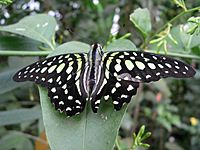Graphium facts for kids
Quick facts for kids Graphium |
|
|---|---|
 |
|
| Graphium agamemnon | |
| Scientific classification | |
| Kingdom: | |
| Phylum: | |
| Class: | |
| Order: | |
| Suborder: | |
| Infraorder: | |
| Superfamily: | |
| Family: | |
| Subfamily: | |
| Tribe: |
Leptocircini
|
| Genus: |
Graphium
Scopoli, 1777
|
| Species | |
|
(Incomplete list; 100+ total) |
|
Graphium is a special group, or genus, of butterflies known as swallowtails. Many people call them swordtails because some of them have long, pointy tails on their back wings. These beautiful butterflies live in different parts of the world, including Eurasia, Africa, and Oceania. There are more than 100 different kinds, or species, of Graphium butterflies, and most of them live in warm, tropical places.
Contents
What Makes Graphium Butterflies Unique?
Graphium butterflies are part of the larger swallowtail family, which is famous for its large size and often colorful patterns. While some Graphium species have long, sword-like tails on their hind wings, others do not have any tails at all. This variety makes them very interesting to study.
Where Do Graphium Butterflies Live?
These butterflies can be found in many different environments. Their homes range from dense, wet rainforests to open, grassy savannahs. This means they are quite adaptable and can thrive in various climates across their native continents.
What Do Graphium Butterflies Look Like?
The colors and patterns on Graphium butterflies can be very different from one species to another. Some might have bright, bold colors, while others are more subtle. This wide range of appearances helps them blend into their specific habitats or stand out to attract mates.
Interesting Behaviors of Graphium Butterflies
One common behavior you might see with Graphium butterflies is called "mud-puddling." This is when butterflies gather in groups on wet soil, mud, or even animal droppings. They do this to drink liquids that contain important minerals and salts. These nutrients are very important for their health and for reproduction.
Why Do Butterflies Mud-Puddle?
When butterflies mud-puddle, they are not just getting water. They are absorbing essential minerals like sodium, which are often missing from the nectar they drink from flowers. These minerals help them with many body functions, including laying healthy eggs. It's like a natural vitamin supplement for them!
The Life Cycle of a Graphium Butterfly
Like all butterflies, Graphium species go through a complete metamorphosis. This means they change completely from one form to another during their lives.
From Egg to Caterpillar
The life of a Graphium butterfly begins as a tiny egg, usually laid on a specific "host plant." Once the egg hatches, a small caterpillar emerges. This caterpillar's main job is to eat and grow. It will shed its skin several times as it gets bigger.
The Pupa Stage
After the caterpillar has grown enough, it forms a pupa, also known as a chrysalis. Inside this protective casing, amazing changes happen. The caterpillar's body transforms into the adult butterfly. This stage can last from a few weeks to several months, depending on the species and the environment.
The Adult Butterfly
Finally, the adult Graphium butterfly emerges from the pupa. Its wings are soft at first, but they quickly harden. The adult butterfly's main goals are to find food (usually nectar from flowers), find a mate, and reproduce. Once it lays eggs, the life cycle begins again.
Images for kids


